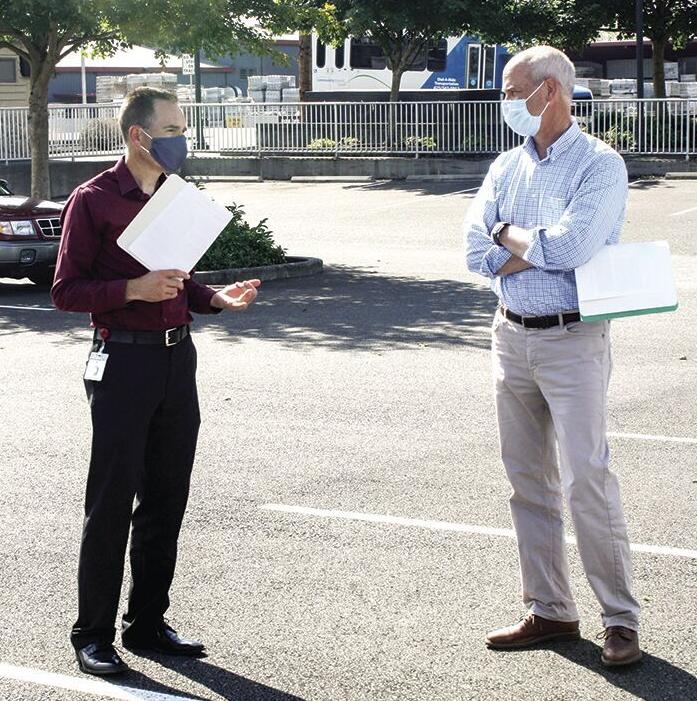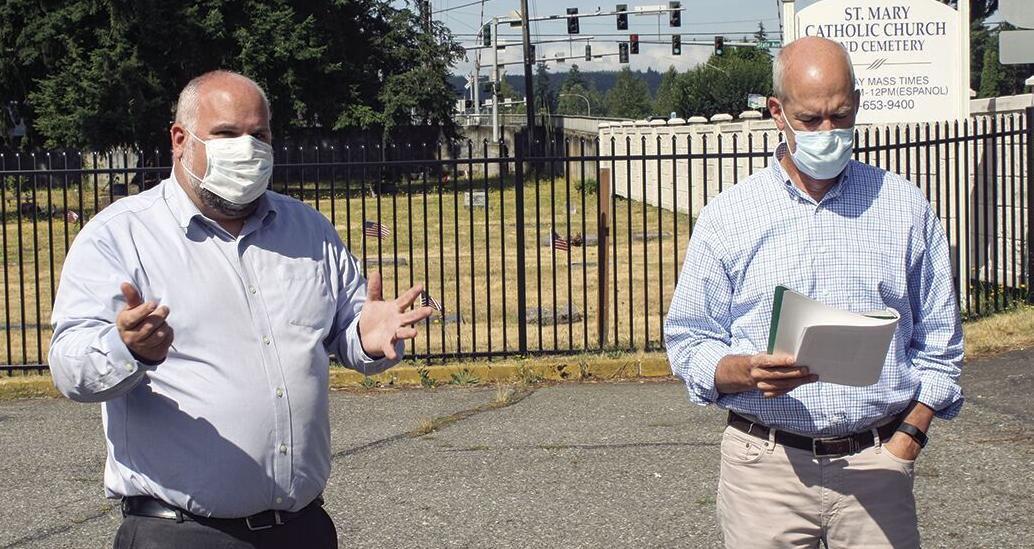U.S. Rep. Rick Larsen met with Marysville officials on Aug. 7 to discuss important transportation projects the city is currently constructing or hopes to begin in the near future.
Marysville city officials accompanied Larsen on a tour of the projects.
Cities receive funding from a variety of sources to build new roads, including federal funds and state funds.
"There is a role for the federal government to help our state and local governments provide good transportation alternatives and options," said Larsen.
Although not impossible, it is often difficult for cities to build projects with only their own funds.
"When you've got these cities that are suburban like Marysville, they are in a position where they are floating in that in-between area," said Larsen."They need the federal assistance that is attached to state and local money, and it's important to do that in a way that is planned and thoughtful."
The Moving Forward Act is one of the more recent pushes for federal transportation funding. The bill has passed in the House Transportation Committee and has been incorporated in the Invest in America Act, which is a broader infrastructure funding bill.
"What makes the Moving Forward Act unique is that we are trying to make our transportation system cleaner and greener. There is an investment in low- and no-emission buses," said Larsen.
Larsen and Marysville officials took a look at areas where new interchanges are planned for the future.
That includes the planned 156th Street interchange, which the city has secured funding for, however they still need to work with the federal government as it involves a change to I-5.
"With a lot of the development coming into the area, all those businesses are counting on the interchange coming into the area," said Jeff Laycock, a city engineer for Marysville.
The other big interchange, also connecting to I-5, will provide another route at the south end of the city at SR-529. Construction of this interchange is expected to begin soon.
"The northbound and southbound commuters are going to use this route," said Laycock, as it is designed to take some pressure off of the interchange at Fourth Street.
A projected 15,000 vehicles per day will use the new route, which will be a significant increase.
That's why Marysville is putting together a First Street Bypass that will provide another route from the downtown to the Sunnyside area.
"The impetus for getting that done quickly was really the SR-529 interchange, because if we didn't have this bypass you'd have all this traffic colliding at Fourth [Street] and State [Avenue], so this will take a lot of that off," said Marysville Mayor Jon Nehring.
The SR-529 interchange was also a priority project for the city as it provides a way into Marysville that goes around the train tracks which can back up traffic to the highway.
Train traffic has been a frequent problem for the city and they are looking at other projects to help alleviate it, such as the Grove Street overcrossing.
"In 2015 we did a study on all our crossings to see what would be the best location for an undercrossing or overcrossing," said Laycock. "This location was, in terms of cost, the most feasible and also had enough space."
The city pursued a federal grant, the Consolidated Rail Infrastructure and Safety Improvements, or CRISI grant, that could have provided the funds for the project.
"It is a very hard grant to compete with," said Kevin Nielsen, Marysville's public works director. "There was only two projects funded in the state."
City officials said they were encouraged to re-submit next year though so it may be a project that is awarded the grant in a less competitive year.
Another area the city was denied CRISI funding is at 156th Street, which has a railroad crossing that was closed by Snohomish County in the early 2000s before the area was annexed by the city of Marysville.
"Since this is a closed crossing it does not qualify for CRISI funding," said Laycock.
Since the Seven Lakes area and Lakewood area have been more developed, reopening the closed route could have an impact on clearing Lakewood traffic.
Finally, city officials looked at the State Avenue corridor, which is currently being widened and potential work at the 88th Street corridor, which Marysville officials hope to improve in the future.
There is only one remaining area of State Avenue that is not five lanes and that area, between 100th Street and 116th Street, is currently receiving two phases of construction to widen the road.
"Things happen on I-5 and where does the traffic go? State Avenue," said Laycock, so it is important to clear the current bottlenecks.
The current work will replace a culvert between 100th and 104th Street.
"This was one of our biggest fish restrictions as well, so the Tribes are big supporters of this project as well," said Nielsen.
The second phase of the project, which is widening the area between 104th Street and 116th Street is designed but requires funding.
"We'll be applying for Transportation Improvement Board funds," said Laycock.



(0) comments
Welcome to the discussion.
Log In
Keep it Clean. Please avoid obscene, vulgar, lewd, racist or sexually-oriented language.
PLEASE TURN OFF YOUR CAPS LOCK.
Don't Threaten. Threats of harming another person will not be tolerated.
Be Truthful. Don't knowingly lie about anyone or anything.
Be Nice. No racism, sexism or any sort of -ism that is degrading to another person.
Be Proactive. Use the 'Report' link on each comment to let us know of abusive posts.
Share with Us. We'd love to hear eyewitness accounts, the history behind an article.